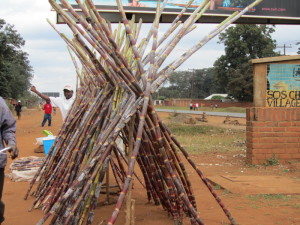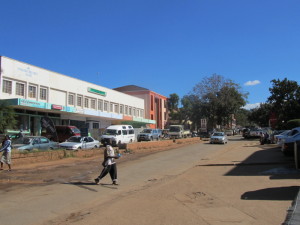September 11th, 2010
Most parents are proud, as well as quite relieved, when their child succeeds as an individual. These feelings are no different when that child is a baboon (I mean this literally, not figuratively). I left Betty and Malawi over a month ago with an agonizing sense of guilt. Did I really teach her any life skills? Leaning to crack peanuts was one of our favorite activities, but unless she was planning to move to a peanut farm in Georgia, she was out of luck–peanuts are not indigenous to the African bush. But then again, at some point in her life, there would be other shells or husks to force open.
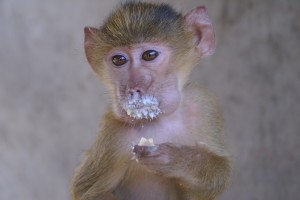
Betty still loves Bananas
Read the rest of this entry »
Tags: baboons, baboons in Malawi, baby yellow baboons, delicious expeditions, kris rudolph, Malawi, primate rehibilitation, volunteer with primates
Posted in Africa | No Comments »
July 13th, 2010
“The black mamba was eye level with the passengers in my car. It was looking inside the open window, balanced on its tail, serpent tongue flickering in the sun,” George said when it was his turn to tell his best safari story. “I didn’t see the snake when I pulled to a stop on the dusty, dirt road, but when a long, narrow, dark figure jumped straight up in the air I shouted for the passengers to stay still, not to move an inch or even take a deep breath. The deadly mamba would attack at the slightest move. It stayed there for about 15 minutes, before lying down and crawling back into the bush. It was the longest 15 minutes of my life.”
“Luckily, the last time I saw a black mamba on the road,” Peter, the thin, bald African man on my left chimed in, “I was able to shout for the passengers to roll up their windows just before it stood up.”

Giraffes & Zebras
Read the rest of this entry »
Tags: Crocodile Valley, delicious expeditions, kris rudolph, Luangwe National Park, safari, single woman travel, Zambia
Posted in Africa | 1 Comment »
July 5th, 2010
The drive to Lake Malawi wasn’t very long, but with the intense sun and vast amounts of dust blowing through the open car windows, I couldn’t wait to get there. A barren land of mud huts, with thatched reed roofs, and scattered goats, stretched out in front of me. Bicycles, cows, chickens and pedestrians, carrying everything from sugar cane to buckets of charcoal, balanced perfectly on their heads, flashed before me as we made our way to Africa’s third largest lake.
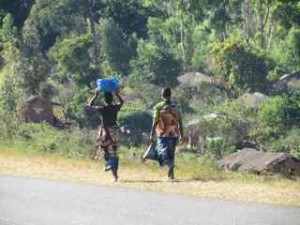
Village women
Read the rest of this entry »
Tags: Cool Runnings, Malawi, Senga Bay
Posted in Africa | 1 Comment »
June 27th, 2010
There are pivotal moments in one’s life when a decision is made and the consequences suffered. Many times our choices lead us in a new direction, guide us down a different path, and then we hope and prey that our hard-earned wisdom does not fail us.
I came to a crossroad this past weekend when asked if I wanted an ensuite bathroom at the Mvuu Lodge campsite in Liwonde National Park–Malawi’s largest and most important, renowned for its large herds of wild elephants. I debated for a long time, not wanting to spend the money, but I was tempted by the thought of my own private bathroom after weeks of sharing with an entire family. Even though I knew it was a self-centered, needless luxury I decided to splurge on my weekend safari.
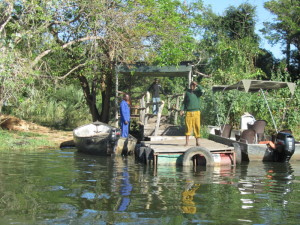
Entrance to Mvuu Lodge
Read the rest of this entry »
Tags: African safari, delicious expeditions, elephant park africa, kris rudolph, Liwonde National Park, Malawi, Mvuu Lodge
Posted in Africa | 1 Comment »
June 23rd, 2010
In took me only a few days to sniff out a good Italian restaurant with proper cappuccino in Lilongwe. I could eat like a local, but unfortunately my western palette can’t handle the monotony of the diet: nsima or white rice with an occasional roasted chicken or goat.
Nsima is the staple of Malawi (and most other African countries). It’s a mixture of powdered maize and hot water, blended into a thick paste. American maize was introduced by the Europeans in the 1800s, then later planted in great quantities during the famine of the 1970s. It’s the main crop of the country, second only to tobacco (Malawi’s only export)–a cheap filler for an empty stomach with little nutritional value.
Read the rest of this entry »
Tags: delicious expeditions, food in malawi, kris rudolph, Lilongwe, Malawi, single woman travel africa
Posted in Africa | No Comments »
June 13th, 2010
“Great Potential Business Consultant Offices”, written in bold black letters on a crumbling building, flashed before me as I turned a corner in old town Lilongwe. Within seconds I decided to steal the idea and start a branch in San Miguel. I have a talent for telling people what to do, so I think I’d be a natural at spouting great potential business ideas, tailored to each and every individual.
Anxious to get started, I’ve decided to take Betty on as my first client (see Baby Baboon Love for full story). Through astute observation, I’ve noticed that she’s not particularly fond of being a baboon and prefers human contact (which isn’t necessarily good) to stinky, hairy animals. Like any good mother, I want to give Betty every opportunity in life, so if the baboon in the bush thing doesn’t work out, I’m prepared to set her up in her own spa business.
Read the rest of this entry »
Tags: baboons, Malawi
Posted in Africa | 1 Comment »
June 7th, 2010
I feel in love on my first day of work in Malawi. It was love at first sight just like in the movies. With just one glance I knew I would always love Betty—a 3 month old orphaned baboon at the animal center.
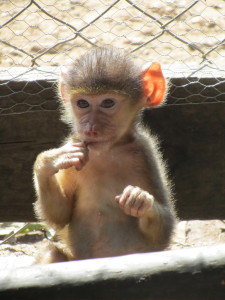
Betty’s Beauty Shot
On my second day of work I offered to feed Betty, not believing that the other volunteers weren’t lined up begging for the task. I watched Henry, one of the animal carers, prepare her special diet: hot water, powdered milk and a banana, all mashed together, then placed on a small, plastic green plate. The meals I prepare are usually a little more complicated, so I assured Henry I could handle the multiple feedings, adding a chopped boiled egg once a day for protein.

Betty at Breakfast
Unfortunately Betty had a traumatic youth (if you can say that about someone 3 months old). Her mother was killed for bush meat and she was taken to be sold in the illegal animal trade. Luckily, she was saved somewhere along the way and brought to the animal center when she was about a month old. At that age baboons have to be hand raised or they will die, so Betty lived with a local woman where she was looked after 24 hrs. a day.
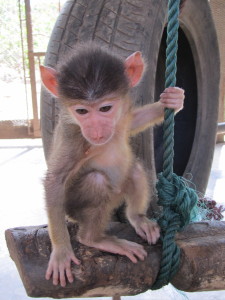
Playtime
When I arrived at the center Betty had just been placed with a surrogate baboon mother, Ida, who took her job seriously reaching for the baby, but Betty wasn’t interested. She still thought she was human and didn’t like a big baboon in her enclosure. I’m entering the picture at this difficult transitional phase.
I think Betty also experienced our great bond. When I fed her for the first time she nestled herself into my lap and went to sleep, wiping her dirty, little banana mouth all over my pants before dozing off. Henry said she had never done this with anyone before.
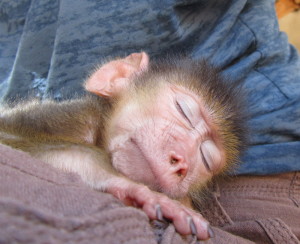
A very tired baby baboon
ps—Betty will eventually grow into her Dr. Spock ears.
Tags: baboons, Malawi
Posted in Africa | 3 Comments »
June 2nd, 2010
In order to start a fire the following procedure can be followed:
-Collect tinder
-Light tinder and place kindling on top
-Add on twigs, forming a “tepee”
-If needed, blow at base of the tinder
-Start adding firewood and build up when first piece catches
I begin to panic after reading these instructions in the Lilongwe Wildlife Centre volunteer manual. How am I going to eat for a month in Africa using only fire? I’ve never really spent much time in the great outdoors, so even though I know my way around a professional stove, the transition to Queen of the Campfire isn’t going to be easy.
In anticipation of my month of potential starvation in the bush, I decide a few days of South African food and wine is a necessity before setting out on my Malawi adventure. Taking a little detour, I have the good fortune to be invited to Franschhoek, in the nearby wine country, as the guest of a local vineyard owner and tour operator. A friend of a friend, Wendy of Wineland Experiences shows me why her town has achieved culinary fame. For the past 10 years the country’s best chefs have flocked to this area making it the Napa Valley of the African continent.

Franschhoek Vineyard
Read the rest of this entry »
Tags: Franschhoek, South Africa
Posted in Africa | 1 Comment »
May 17th, 2010
In anticipation of my upcoming trip to Africa, where I’ll be working at the Lilongwe Wildlife Center in Malawi, I made an appointment to get my long list of vaccines while in New York. This is not a normal tourist-related activity, however living in a small town in Mexico stateside visits basically boil down to a list of errands. I went to a prominent university hospital and endured just the beginning (three visits in total) of the poking and prodding. The nurse asked why I needed a rabies shot, so I told her that there would be a lot of primates at the center and that an animal bite was a realistic possibility. She pulled away from me with a worried expression on her face. “Didn’t they warn you about monkey herpes?” she asked. No, I assured her that I had never heard of such a thing and it wasn’t mentioned in the 95-page volunteer manual. There was a large section on vermin and how to start your own fire for making meals, but definitely nothing on monkey herpes. I would have remembered that.
“Well, you need to be very careful,” she told me. “If you’re bitten by a herpes-infected monkey you’ll most likely die.” I pulled my aching rabid arm off the small metal table and said, “No way!” She defended her statement by showing me the university research from her computer. So while the waiting room continued to fill with impatient patients, looking at their watches and tapping their feet, the nurse and I went over the case studies. She spouted reliable statistics such as, “80% fatality rate after your central nervous system shuts down.” I answered with the equally intelligent statements like, “No way!”
I thought the worst of my problems would be crocodile toes. This is the technically correct medical term I made up for when a crocodile bites off half of your foot. My volunteer manual warns against going within 25 feet of the nearby river, since that’s where the abundant local reptiles like to sun themselves. I’m not a very good judge of distance, especially after living in a world of meters, not feet, for so long. With this in mind, I know I’m a pretty good candidate for crocodile toes.
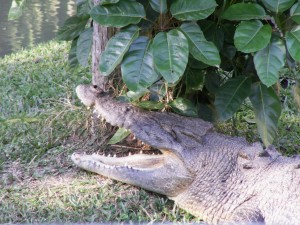
Crocodile looking for toes
Read the rest of this entry »
Tags: rabies shot, Raven the Cake Man, red velvet cake, vacacines
Posted in Africa, New York | No Comments »





